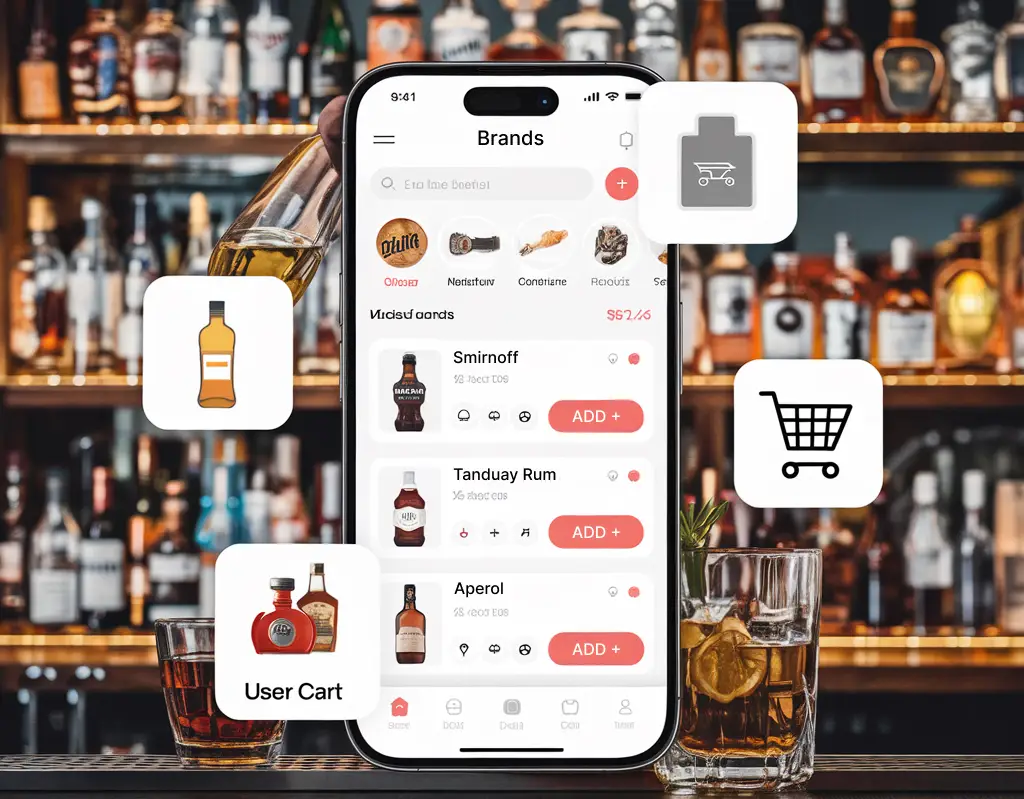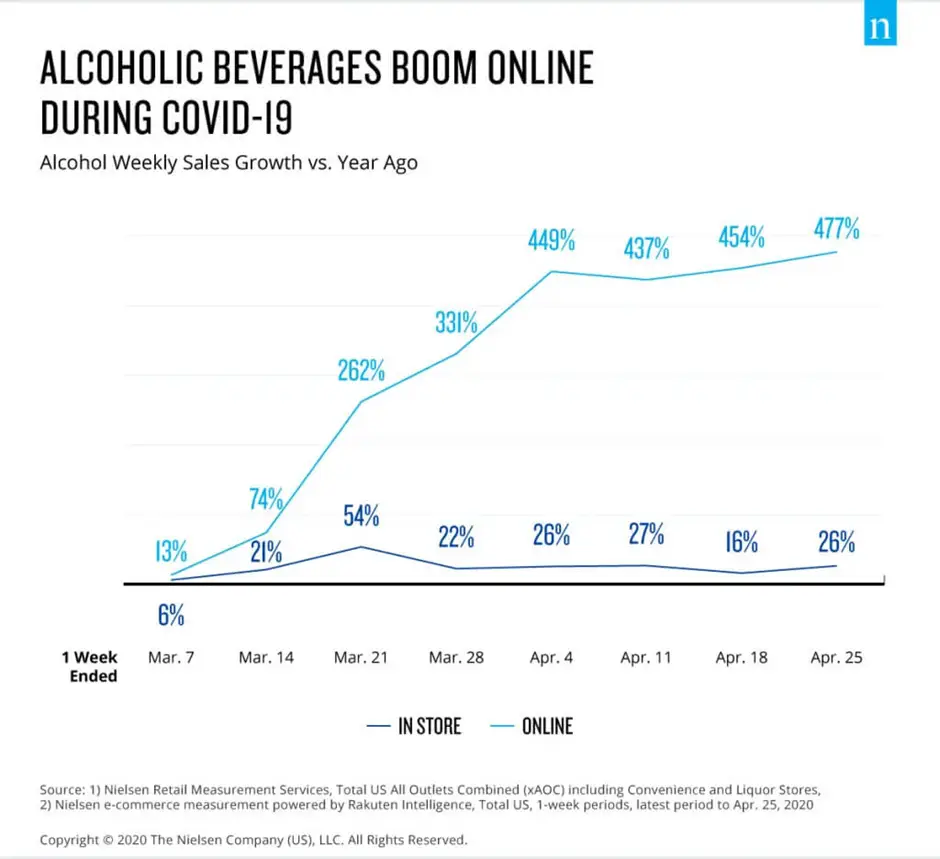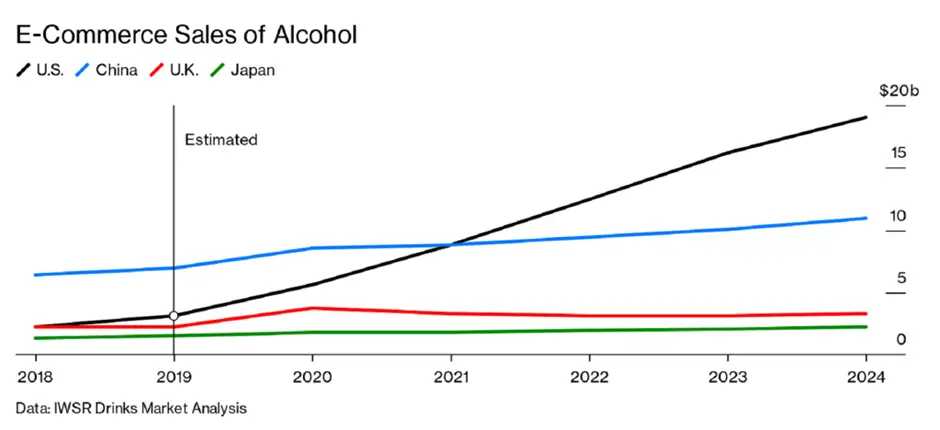In today’s rapidly changing society, the increasing demand for on-demand services is obvious. Efficiency is critical, from food delivery to grocery shopping to wine delivery apps. One of the most popular is the wine delivery service. The rise of alcohol delivery app development built on platforms like Drizly has changed the way people buy their favorite drinks. But if you dig a little deeper, you might wonder what it takes to build an alcohol delivery app like Drizly.
Well, you’re in luck! The demand for alcohol delivery app development is huge, and many options are available for those who want to create their own platform. Whether you are a liquor delivery app developer or an alcohol delivery app development company, there are many things to consider before embarking on this journey.
If you are thinking about creating an on-demand alcohol delivery app like Drizly, this article will give you a complete guide. We discuss key features, the required technology stack, development costs, and revenue models. By following these steps, you can create a successful wine delivery app that satisfies your target audience and generates revenue through commissions and shipping fees.
Start your journey to create an alcohol delivery app like Drizly!
If you want to join the rapidly growing wine delivery market, read this article to learn more.

Why Invest in Alcohol Delivery Apps?
Just like the successful food and beverage delivery apps, liquor delivery apps also hold great promise for startup enthusiasts. According to AlliedMarketResearch, the entire alcoholic beverage market in 2017 produced an impressive value of US$ 1.439 billion. Moreover, it is expected to reach more than $1.6 trillion by 2025, with a CAGR of 2.0% from 2018 to 2025. Even the Indian market is likely as the IMFL (Indian Made Foreign Liquor) sector could be worth Rs 10,000 crore. $30,000 billion by 2026, growing at an unsustainable CAGR of 5.2%.

Therefore, to join this trend, you can consider an alcohol delivery startup that delivers wine drinks to users in front of them through liquor delivery apps like Drizly.
Facts and Statistics
It is important to know the market you are entering. Before we explain how to build an application, we will help you understand the big picture and the situation in delivering alcohol on demand. Check out the statistics and data below to find out more.

• The global alcohol e-commerce market is expected to exceed USD 42 billion by 2025.
• The IWSR (International Wine and Spirits Registry) predicts that wine sales through e-commerce will increase by 66% between 2020 and 2025.
• Wine delivery demand in the US increased monthly in 2017. Up to almost 90% in one year. That number is higher in the post-COVID-19 market.
• By 2021, wine sales through grocery apps will be four times higher than in 2019, reflecting increased demand during the pandemic.
•In the États-Unis, 12 states allow the delivery of all types of alcohol, while 31 states allow only the delivery of beer and wine. The remaining seven states do not allow the delivery of any alcohol.
• China is the country with the highest number of online drink buyers. About 70% of online alcohol delivery orders are placed through apps.
• 62 percent of Brazilian buyers and 32 percent of US buyers say they are going to be able to do so. Order wine delivery through a mobile application. This shows that a website alone is insufficient for an online liquor store owner.
• 47% of Millennials like to drink at home, but 28% feel it takes too much effort to go out and buy a drink.
• Drizly, Saucey, and Minibar are some of the main players in the wine e-commerce industry. 70% of Drizly’s sales come from its mobile app.
• According to IWSR, the demand for online delivery of wine is increasing in the US and India, which faces strong competition from China.
The concept of online alcohol delivery is new to many people around the world. In fact, awareness is one of the biggest hurdles facing the industry. However, the market is growing, and the demand for online alcohol delivery has increased since the pandemic outbreak. As awareness increases, the demand for new wine delivery platforms will increase.
Key Highlights of the Alcoholic Beverages Market Report:
| Aspects | Détails |
| Market Size By 2031 | USD 2036.6 billion |
| Taux de croissance | CAGR of 2.2% |
| Forecast period | 2021 – 2031 |
| Report Pages | 279 |
| Beer Type | Ale,Lager,Hybrid |
| Distilled Spirits Type | Rum,Whiskey,Vodka,Others |
| Wine Type | Sparkling Wine,Fortified Wine,Others |
| Distribution Channel | Convenience StoresOn PremisesLiquor StoresGrocery ShopsInternetRetailingSupermarkets |
| Convenience Stores | On-Premises,Liquor Stores,Grocery Shops,Internet Retailing |
| By Region | North America (U.S., Canada, Mexico)Europe (Germany, France, UK, Italy, Spain, Rest of Europe)Asia-Pacific (China, Japan, India, South Korea, Rest of Asia-Pacific)LAMEA (Brazil, South Africa, Argentina, Rest of LAMEA) |
| Key Market Players | Pernod Ricard,Bacardi Limited,Carlsberg Group,Tsingtao Brewery Co., Ltd.,Constellation Brands, Inc.,Brown-Forman Corporation, and more… |
What is Drizly?
Drizly is an on-demand alcohol delivery application through which customers can locate and purchase alcoholic products online. Established in 2012, we source our products from local liquor stores to provide a diverse range of beers, wines, and spirits.
Drizly is active in over 100 cities in North America and has been downloaded more than 1 million times.
With the increasing trends of home delivery apps and on-demand food delivery apps, Drizly has emerged as a key player in the on-demand alcohol delivery market. Customers love this site because of the easy-to-use interface and the fast delivery service.
How Does Alcohol Delivery App Work? – Business Model
The business model of Drizly in the alcohol delivery app development is quite effective and straight forward. The company is involved in the selling of wines directly to the consumers but it also cooperates with wine retailers in its local markets and offers an online shop. Therefore, Drizly provides its customers with a wide range of products and is one of the most successful wine delivery applications in North America.
Based on this model of growing liquor delivery application, Drizly can cooperate with a vast number of wine shops in the local area, which will increase the assortment of products offered to customers in North America. Drizly’s delivery model is very effective, the order is delivered to the customer within an hour of placing the order.
Drizly’s fee-based model is also very flexible and can accommodate the expansion of the company by partnering with more liquor stores in the local area and in new cities as the company advances. The company’s revenue model is also very lucrative since it gets a commission on every sale that is made through it.
Apart from its model, Drizly provides mobile application development solutions in the US to the wineries who are willing to create their own alcohol delivery application or an on-demand wine application like Drizly. The service enables liquor stores to create their own on-demand alcohol delivery applications and utilizes Drizly’s technology stack for the purpose. In return, Drizly gets a percentage of the revenue that is made by the app.
Benefits of Alcohol Delivery Apps
Starting an alcohol delivery service business has benefits for everyone. This is a bonus because the wine business has been profitable, and the e-commerce alcohol sector is booming, especially after the pandemic hit the world. This business is a perfect combination of an on-demand delivery app and a liquor trade. Benefits for everyone include: –
Clients
Having wine bottles and cans delivered directly is great for consumers and wine lovers because round trips are no longer necessary. Benefits for wine consumers include:
• Let customers order from their favorite brands
• Home delivery. he did not leave the house
• Lots of brands to choose from if you want to try something different
• Various discounts and coupons that save a large amount of money
• There is no waiting list. You don’t have to manage your time
• Online payment: safe and easy
Businessperson (the liquor shop owner)
Liquor store owners are also excited about the lucrative business as beverage delivery apps allow consumers to pay and receive drinks hassle-free without visiting the store:
• Create an even larger consumer base beyond geographic boundaries
• Increase revenue through broad business visibility across applications
• Easily display multiple brands in one application
• Efficient inventory management and local wine inventory application integration
• Less chance of fraud as it is a non-cash transaction
App owner
There are many benefits for non-liquor store merchants who also have an app:
• Easy and stable income can be obtained without managing inventory or having a physical store.
• A liquor delivery application business model can provide steady revenue by registering several liquor stores.
• Good network with suppliers and other companies related to the wine business and good income potential.
• Edit and manage liquor store owner and consumer profiles through a single online liquor delivery service application.
Top Most Important Feature for Alcohol Delivery Application
1. User Panel:
The user dashboard is an important part of any liquor delivery app as it is a hub for users to explore its features. It should be intuitive, easy to use, and provide easy navigation. This dashboard allows customers to create accounts, search for products, place orders, track deliveries, and manage order preferences and history.
2. Admin Panel:
This feature allows app owners or device administrators to manage and monitor app operations such as inventory management, order tracking, user management, and analytics.
3. Delivery Panel:
The delivery dashboard is where delivery staff manage their deliveries. The dashboard should include real-time tracking, route optimization, and delivery confirmation. An effective delivery dashboard can help reduce delivery times, increase customer satisfaction, and increase revenue.
4. Real-Time Tracking System:
Real-time tracking is a key feature of the wine delivery app. It allows users to monitor their orders from delivery to delivery, plan their schedule accordingly, and stay up-to-date on delivery and estimated arrival time. We provide an easy way for customers to track orders in real-time, ensuring a smooth and efficient shipping experience.
5. Find the Nearest Store:
The app should include the ability to find the nearest liquor store that serves the user’s favorite drink. You don’t have to search in multiple stores anymore, saving time and effort. Easily access desired products based on your current location or search criteria.
6. Repeat Order:
The re-order function in the wine delivery application is very important because it allows users to easily re-order their favorite drinks with just a few clicks, saving time and effort. This convenience not only benefits users but also helps increase revenue for app owners. Improving the reorder process allows customers to easily access their favorite products or repeat previous orders, improving the overall user experience.
7. Push Notifications:
Push notifications are an important feature to keep your customers active and informed. We will provide you with timely updates on order confirmations, delivery status, promotions, and other relevant information. Wine delivery apps can use push notifications to notify users of pending orders, notify them of new promotions, and send important updates that improve the overall app experience.
8. Catalog:
A comprehensive catalog of available alcoholic beverages is an essential feature of wine delivery apps. You should provide an organized and user-friendly interface that makes navigation easy for your customers. Your catalog should include detailed product descriptions, accurate pricing information, ratings, and reviews. Additionally, you should include high-quality images of your products to enhance the user experience.
9. Payment Options:
Wine delivery apps should offer customers multiple payment options, such as credit/debit cards, digital wallets, and cash on delivery. Offering a variety of payment methods increases user engagement and makes your site more accessible to a wider audience.
10. Profile Management:
Profile management is an important feature that allows users to efficiently manage personal information such as name, address, and contact details. This feature simplifies the ordering process, saves your users time, and improves the user experience of your app. This allows users to easily manage their personal information, shipping address, payment details, and settings directly in the application.
11. Smart Filters:
Smart filters enhance your user experience by narrowing your search results based on your preferences, such as beverage type, price range, or brand. This feature facilitates quick and easy navigation, allowing users to easily find the desired product.
12. Multilingual Support:
Multilingual support is an important feature for wine delivery apps that target a diverse user base. This allows users to interact with your application in their preferred language, allowing you to reach a global audience. To ensure inclusion and improve user experience, apps should offer language options such as English, Spanish, and French.
13. Chatbot Integration:
Chatbot integration is an emerging trend in the wine delivery app industry. By collaborating with AI chatbot developers, the app can help users with questions, queries, and recommendations related to personalized orders. This integration simplifies user ordering, delivery tracking, and problem resolution in one convenient platform. With the development of chatbot applications, AI bots improve the user experience by providing fast and supportive assistance at every step of the ordering process.
How to build an alcohol delivery app like Drizly?
So, let’s get down to business and learn how to build an alcohol delivery app. Whether you want to build an app like Drizly or bring your own ideas to life, our mobile app development guide can help you do both. So follow the steps below to create your own wine delivery app.
Step 1: Conduct market research
The stronger your research, the greater your chance of success. Research the market thoroughly to determine the scope of your idea and the challenges it will face. Also, analyze your target customers, competitors, and the market in general. Analyze your budget and resources and align them with your goals.
This will help us move in the right direction. At this stage, you can also start the initial preparations for developing, launching, and marketing your app. In fact, you can start creating wireframes and app prototypes to visualize your ideas and share them with others. You can also use your app prototype to raise funds and find the right partners and stakeholders for your app.
Step 2: Get legal help and clearance
It is no secret that buying and selling alcohol has its legal nuances. Many sites require special permission from the government and administrative agencies. Do not make large investments or commitments without obtaining appropriate consent.
Get legal help to ensure compliance with all laws and regulations, national or international (depending on the scope of your business and its use case). In some cases, this may be a one-time process, but in other cases, it should be done regularly and according to certain guidelines. Once you master this phase, you can begin to progress with confidence.
Step 3: Design and develop the app
This step is easier if you already have a prototype ready. Complete the app’s UI and UX and finalize the design and layout of your mobile app. Choose a development method or technology and build your application.
How Much Does it Cost To Develop A Drizly-Similiar App
The cost of developing an app like Drizly depends on several factors, as mentioned above. Here’s a breakdown of the potential costs:
• App Design: $5 000 à $15 000
• App Development: $30,000 to $100,000+
• Développement back-end : $15,000 to $30,000
• Intégration API : $5 000 à $10 000
• Testing and Launch: $5 000 à $10 000
• Maintenance en cours : $5,000 to $10,000 per year
The cost of developing an app like Drizly with Miracuves depends on several factors, as mentioned above. Here’s a breakdown of the potential costs:
| Service | Cost ($) |
| Base Solution ( Web & Apps ) With Source Codes | $1899 |
| Application Web Déploiement | Gratuit |
| App Publishing Support | Gratuit |
| Custom Language other than English (Per language) | $450 |
| Custom payment Gateway ( other than included) Per gateway | $690 |
| Annual Maintenance continue | $900 |
Note: It is important to note that these cost estimates are approximate and may vary depending on your specific needs, complexity, and the location of your development team. In addition, this estimate does not include costs such as application marketing or server hosting, so these should also be taken into account.
To get a more accurate cost estimate for your app development project, we recommend that you consult with a trusted custom web app development company in the US, UK, and India that can assess your needs and provide you with a customized quote.
How Do Liquor Delivery Apps Like Drizly Earn Money?
On-demand alcohol delivery apps like Drizly generate revenue using multiple revenue streams. Here are some common ways these apps make money.
Commission-Based Revenue:
The on-demand liquor delivery app charges a fee for every sale made through the platform. Commission rates may vary by company and market. This fee is a percentage of the total transaction amount and is charged to liquor stores or retailers to facilitate sales through the app.
Delivery Fee:
The app also charges a shipping fee to cover the cost of shipping the product to the customer’s location. Shipping costs may vary depending on the market and the distance between the store and the customer. The application company usually sets these fees and do not depend on the commission.
Convenience Fee:
Some on-demand alcohol delivery apps offer customers the option to pick up their product at a specified time (usually a faster delivery service). In this case, a convenience fee will be charged to customers who choose this option. This fee is an additional fee that the customer may pay to get the item faster.
App Development Services:
In addition to fees charged to liquor stores and customers, several on-demand liquor delivery apps offer mobile app development services to liquor stores in the US, UK, and India who want to create their own apps. Using the skills and technologies of the existing stack, this app helps the wine shop to create a unique delivery application that can compete in the market. In return, the app company receives a percentage of the revenue generated by the app.
These revenues enable on-demand liquor delivery apps to generate revenue while providing convenience and delivery services to customers and expanding the reach of liquor stores in the market.
Top 5 on-demand Alcohol Delivery Apps
There are many online alcohol delivery apps in the market. However, here are the top 5 and their trading strategies:
Drizly
Drizly is a marketplace that connects wine consumers with nearby wine shops. You can get an on-demand alcohol delivery service with Drizly. The entire process is completed with a simple swipe on the consumer application.
Klink
Klink is a cost-sharing bottle service app that allows consumers to have the best and most exclusive VIP experience without paying VIP prices for wine. The app’s unique on-demand liquor delivery model allows friends and strangers alike to share the cost of bottles of wine at top clubs.
Minibar
It’s like having an entire minibar wine store in your mobile app. Considered to have the largest selection of beer, liqueur, ice, mixers, wine, and other alcoholic beverages, Minibar is the best example of a highly successful online alcohol delivery company.
Boxed
Boxed is a popular wholesale alcohol delivery app loved by millions, especially for special events and parties. This unique application offers the best collection of groceries, glasses, snacks, non-alcoholic beverages, as well as alcoholic beverages, and you can order in just a few clicks.
Saucey
Although limited to the San Francisco, Chicago, Los Angeles, and Sacramento areas, the popular wine delivery service delivers them all within minutes. The app is popular among wine lovers because there is no shipping fee or minimum order amount. Order beer, wine, spirits, mixes, snacks, ice, and other party supplies from this great application.
Start Your Own Alcohol Delivery Business Today
By following the steps in this guide to building a wine delivery app, you’ll create a solid roadmap that will lead to a digital product driven by a competitive marketplace. You can contact Miracuves, a renowned mobile app development company, to create your custom liquor delivery app.
Final Thought
From Drizly to Flaviar, there are many successful brands and companies in the wine retail industry. As customers become more aware of on-demand wine delivery, new customers can join the league and become part of an industry where the possibilities are endless. Now is the perfect time to ditch brick-and-mortar stores and think digital.
Add countless premium features like push notifications, consent forms, chat, monetization, and more with easy point-and-click options. Grow your wine business across borders by publishing your app on the Google Play Store and Apple App Store.
FAQ
How can Miracuves help you develop the perfect product for your alcohol delivery business?
After years of app development, we learned how to customize apps for businesses. We are pioneers in customized app development, so we can help you maximize your online liquor delivery business.
What are the current trends in alcohol delivery app development?
Current trends in wine delivery app development include AI-powered chatbots for customer service, voice assistants for ordering, and mobile wallets for payment processing. In addition, many apps include social media integration and personalized recommendations for a seamless customer experience.
What are the trends in wine or alcohol consumption from 2024 to 2026?
The trends discussed in this guide highlight some key ideas. From 2024 to 2026, wine consumers will have higher expectations of their drinking experience, demand for high-quality ingredients, and responsible drinking values. Although the alcoholic beverage industry shows major positive trends, it also faces some uncertainties.
How do you monetize an app like Drizly?
Apps like Drizly follow the same monetization model as e-commerce stores and on-demand delivery apps. It depends on your use case. For example, selling directly to customers generates sales revenue. On the other hand, if you are only an aggregator, your revenue depends on the license fee for all partner stores, as well as shipping and cancellation fees to your customers. Additionally, you can monetize your app by charging users to download your app or generate revenue through advertising and affiliate marketing.





























































